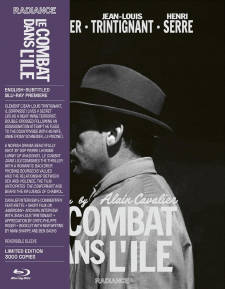Le Combat dans l’île (Blu-ray Review)

Director
Alain CavalierRelease Date(s)
1962 (November 28, 2023)Studio(s)
La Société des Films Sirius/Nouvelles Éditions de Films (Radiance Films)- Film/Program Grade: B+
- Video Grade: A
- Audio Grade: A
- Extras Grade: A-
Review
Le Combat dans l’île (“Duel on an Island,” 1962) is a very good, underrated French drama directed by Alain Cavalier (Thérèse). His screenplay is somewhat simplistic, but the performances by leads Romy Schneider, Jean-Louis Trintignant, and Henri Serre are superb, and the production is beautifully staged and photographed in rich black-and-white by Pierre Lhomme, who shot Melville’s Army of Shadows which this somewhat visually resembles. It also bears more than a passing resemblance to Truffaut’s Jules and Jim, released earlier that year, with the psychopathic Jeanne Moreau character shifted to Trintignant’s. (In Jules and Jim, Serre played Jim.)
Anne (Schneider) is a retired actress, now married to Clément (Trintignant), son of a wealthy Parisian industrialist whose workers are striking. She adores her husband but, personality-wise, they seem complete opposites: she’s ebullient and demonstrative while he’s surly and reticent. She’s also concerned about his association with the mysterious, much older Serge (Pierre Asso). Cleaning their flat, she discovers a bazooka (!) hidden in their closet.
Later, Clément and Serge use the weapon to blow-up the apartment of a socialist politician, and it becomes clear Clément is a member of something like the OAS, the far-right French terrorist organization. Soon after, news reports reveal that a mole within the organization alerted the politician, who survived the attack, and that Clément may be arrested at any moment.
Clément and Anne flee to an isolated watermill where Clément’s childhood friend, Paul (Serre), operates an old-fashioned printing press he uses to print socialist pamphlets. Clément learns the mole’s identity, setting off to South America to assassinate him, while Anne and Paul become attracted to one another.
Cavalier’s unusual style has scenes fading to black and fading back in again, leaving out seemingly important narrative/character information other filmmakers might have included. The audience never learns and can only infer what drives Clément’s extremist behavior, why Anne loves him, why she later falls in love with Paul, etc. After Clément skedaddles to Buenos Aires, a scene opens with Paul and Anne driving toward Geneva. Only gradually does the audience realize they’re going there so she can have an abortion and yet, prior to this, there were only vague hints that the two were becoming attracted to one another, certainly not that they were in love or a had an active sex life. Much of the film is structured this way, with the audience trying to figure out what’s going on within a particular scene or sequence. I’m not sure this is especially effective, but it keeps the viewers on their toes.
It is a little frustrating that we don’t learn more about these relationships. Why does Anne love Clément? Early scenes show him as jealous, controlling (he made her quit acting), judgmental, xenophobic (to a black man, “You’re in France—speak French!”), physically abusive, and one early scene borders on rape. Trintignant excelled playing emotionally aloof types, just as Schneider did playing exuberant ones uninterested in or unable to hide her feelings. Yet we know little more about Clément at the end of the story than we did at the beginning.
Much of what we do learn, small details, comes through the performances, all great, especially Schneider, the most successfully realized of the three characters. She is a wonder. Yet one also supposes Cavalier gave his actors much latitude: much of the blocking, particularly during the love scenes, seems both collaborative and partly improvised on the set.
Cavalier and producer Louis Malle reportedly made the film in response to the political shade given the OAS by many French New Wave directors such as Godard. Clément, certainly, comes across as completely unsympathetic and his actions, especially during the climax, are those of a temperamental child.
Radiance Films’ Blu-ray presents a 2K scan by Gaumont of the original camera negative, which in 1.66:1 widescreen black-and-white is gorgeous throughout. It’s essentially flawless. It captures early 1960s Paris and the French countryside as few films do. Both the exterior and interior compositions are striking and beautiful throughout. The original, uncompressed PCM mono audio is impressive and the optional English subtitles excellent. Regions “A” and “B” encoded.
The Blu-ray is impressively stocked with extra features. They consist of: a 5-minute television interview with Cavalier from 1962; a 13-minute 2011 featurette with Cavalier commenting on images; France 1961, an 8-minute, 2010 short directed by Cavalier about the film; seven minutes of excerpts of Trintignant on Belgian television in 1983; a 37-minute interview with French critic Phillippe Roger about the film; Un américain (1958), a short film (17 minutes) by Cavalier; behind-the-scenes photos, including images from the archive of Louis Malle; a trailer; and a 36-page booklet featuring excellent essays by Ben Sachs, Mani Sharpe, and Pierre Lhomme.
Though not quite a masterpiece, Le Combat dans l’île is an impressive feature debut by Cavalier, notable more for its three lead performances and striking black-and-white compositions than its plot. Highly Recommended.
- Stuart Galbraith IV

